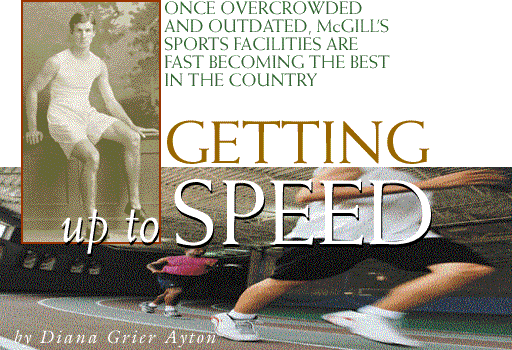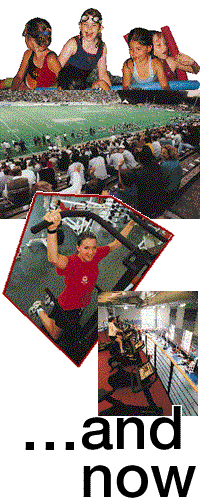
The sounds of saws and hammers have stopped for the moment as workers building new squash courts take a lunch break. One is stretched out dozing on a pile of plywood sheets. But construction has been more or less constant at the Department of Athletics since the early '90s as McGill turns its antiquated sports facilities into a sleek and service-oriented community asset.
Athletics has a long history at McGill, which established organized teams and programs as far back as 1860, and whose students and alumni changed the course of a number of sports. In 1874, McGill was invited to play football against Harvard. The McGill team played a game based on rugby, which allowed running and tackling, while Harvard's game was more like soccer, with the ball advanced mainly by kicking. The teams agreed to play twice, once under Harvard's rules, once under McGill's. The Harvard players enjoyed the rugby-style game so much that the team adopted the McGill rules. Before long, American colleges all along the Eastern seaboard were playing the "new" game.

Above: Molson Stadium, named for McGill super-athlete and war hero Percival Molson (pictured overleaf), as it appeared in 1919. A committee of graduates was responsible for funding and building the Currie Gym.
James Naismith, inventor of the game of basketball. Revenue sources for the gym included the sale of McGill cigarettes.
|
Hockey also evolved from sports brought to Canada by immigrants. Named for the word "hoquet," ancient French for shepherd's crook, referring to the players' hooked stick, the game had been played in North America since the early 1800s. It was always a big, brawling outdoor game, sometimes with as many as 200 players on the ice at once. In 1873, James Creighton, a McGill student, attempted to bring order out of chaos by setting down rules. Two years later, the world's first indoor game was played at the Victoria Skating Rink in Montreal, with each nine-man team captained by a McGill student. A further innovation credited to the McGill version of hockey was the introduction of a flat, circular piece of wood, similar to the puck used today, to replace a hard-to-control round ball.
Students weren't the only inventive ones when it came to sports. James Naismith, BA1887, himself a keen athlete, was teaching at a school in Massachusetts when its dean of physical education issued a challenge. Sports programs in schools everywhere, consisting mainly of dull exercise drills, were having difficulty attracting students. An easy-to-learn game that could be played indoors was what was needed. After a few weeks of thought, Naismith nailed a couple of peach baskets to the balcony railing at each end of the school gym, devised 13 simple rules for play, and the sport of "basketball" was born. It was an immediate success.
McGill offered athletics programs to women shortly after admitting them to the University in 1884, a time when there was debate about whether women should even participate in sports. Royal Victoria College, built for women students in 1899, contained a fully equipped gymnasium, so for several decades women at McGill had much better facilities than men.
It was the death in World War I of Percival Molson, BA'01, one of the most outstanding McGill athletes of any era, that helped push construction of a sports stadium on campus. Molson, who played on a Stanley Cup hockey team at the age of 16, also excelled at track, racquet sports and football as an undergraduate at McGill, and for three consecutive years, he was named the University's best all-round athlete, a feat un-matched since.
He was wounded so severely in 1916 that it took him a year to recover. Awarded the Military Cross for gallantry, he insisted on returning to action and was killed at Vimy Ridge. In his will, he left $75,000 for construction of a stadium on land do-nated by Sir William Macdonald. The remainder of the money came from McGill's first public fund-raising campaign. In October 1919, the Percival Molson Memorial Stadium was officially dedicated.
The threat of another war hastened completion of the next addition to the University's sports facilities. Male students had been complaining about the lack of a gymnasium since the late 1800s. Finally, in 1931, Principal Sir Arthur Currie told the Graduates' Society to get the job done. Plans were drawn up and a committee of alumni raised $190,000 -- including revenue from the sale of McGill cigarettes -- which, combined with a gift from Lady Strathcona, covered the $295,000 cost of the gymnasium. The Graduates' Society hired a contractor in June 1939 and gave him eight months to complete construction, as a facility was now urgently needed to train soldiers. The gymnasium and armoury was named for Currie, who died in 1933.

Above: Happy day campers splash in the new pool.
The fully equipped Fitness Centre will be open from 7 am to 11 pm.
The Montreal Alouettes of the Canadian Football League now play their home games at Molson Stadium to sell-out crowds.
|
The World War II-era facilities stood up fairly well over the years until the pursuit of individual fitness became such a hot trend. By the end of the 1980s, a survey showed that more than 70% of McGill's 20,000 students participated in some form of sport. The pressure on out-of-date facilities built for a student body of 4,500 had became intolerable. Planning was already under way for a multi-million dollar sports complex to be built in four stages. Director of Athletics Bob Dubeau says the project has been "my primary objective" since coming to McGill 22 years ago. "We knew we were going to have to spend many millions of dollars in bringing dilapidated facilities up to par. That's been the most important thing and it's still the most important thing."
Dubeau hasn't been alone in his dedication. Students voted in a 1982 referendum for a fee levy which would go into a building fund. Since then, they have twice voted to extend the pledge, so by 2002, students will have contributed a total of $8,000,000. The administration agreed to divert a portion of proceeds from two capital campaigns to support the new complex, and benefactors like the Molson and Tomlinson families and Seagram Ltd. have made major gifts.
The complex, now expected to cost $32 million, is about two-thirds finished and another $8 million to $10 million is required to complete all four phases, according to Dubeau. The new facilities include a 25-metre, eight-lane swimming pool; a fieldhouse with a banked running track, four courts adaptable for basketball, volleyball or tennis and seating for up to 2,000 people; the Seagram Sports Science Centre, which, with four research labs, is one of the largest units of its kind in Canada; the McGill Sport Medicine Clinic, affiliated with the Montreal General Hospital; and the Weider Varsity Weight Room. Among the projects to be built next are dance and gymnastics studios, a golf range, a rock-climbing wall, and comfortable locker rooms and lounges.
But all this will not be just for the 20-something elite athlete. Denis Kotsoros, BA'86, marketing and promotions manager for the department, says the sports complex is a resource for the entire community. "The ivory tower has a door and one door leads to athletics. Membership is open to everyone. We want these facilities to be city-centred rather than McGill-centred."
A tour during the summer shows a lot of community members taking advantage of the programs. The McGill Sports Day Camp, begun 15 years ago, guides 500 kids a week through activities ranging from horseback riding to fencing. Phil Quintal, BEd'80, who runs the camp with Marla Gold, BEd'79, and Perry Karnofsky, BEd'94, says it fills several important functions. "The first is that the facilities are well used during quiet periods, the second is that the University provides a quality service to the community, and the third is that training and job opportunities are available for 100 students." In one of the new gyms, Martlets coach Lisen Moore supervises an intensive basketball skills program for girls aged 14 to 16. "We deliberately keep it small, no more than 24 girls, so that each one gets individual attention," says Moore. Most of the girls in the program that week are francophone, so training is conducted in French. A hockey school for boys and girls aged 9-16 is offered in August.
Although during the academic year the sports complex serves 700 McGill teams and clubs, Kotsoros says there are quiet times and programs that will appeal to people of any age, whatever their athletic ability. "We offer tremendous variety, all our staff are certified instructors, and we have special rates for staff and for alumni and their families."
So if you want to learn to tango or play tennis, bench press your own weight or get expert treatment for a hurt hamstring, call the Department of Athletics at 398-7000.
|